washer fluid FORD ESCORT 1997 6.G Owners Manual
[x] Cancel search | Manufacturer: FORD, Model Year: 1997, Model line: ESCORT, Model: FORD ESCORT 1997 6.GPages: 191, PDF Size: 2.02 MB
Page 30 of 191
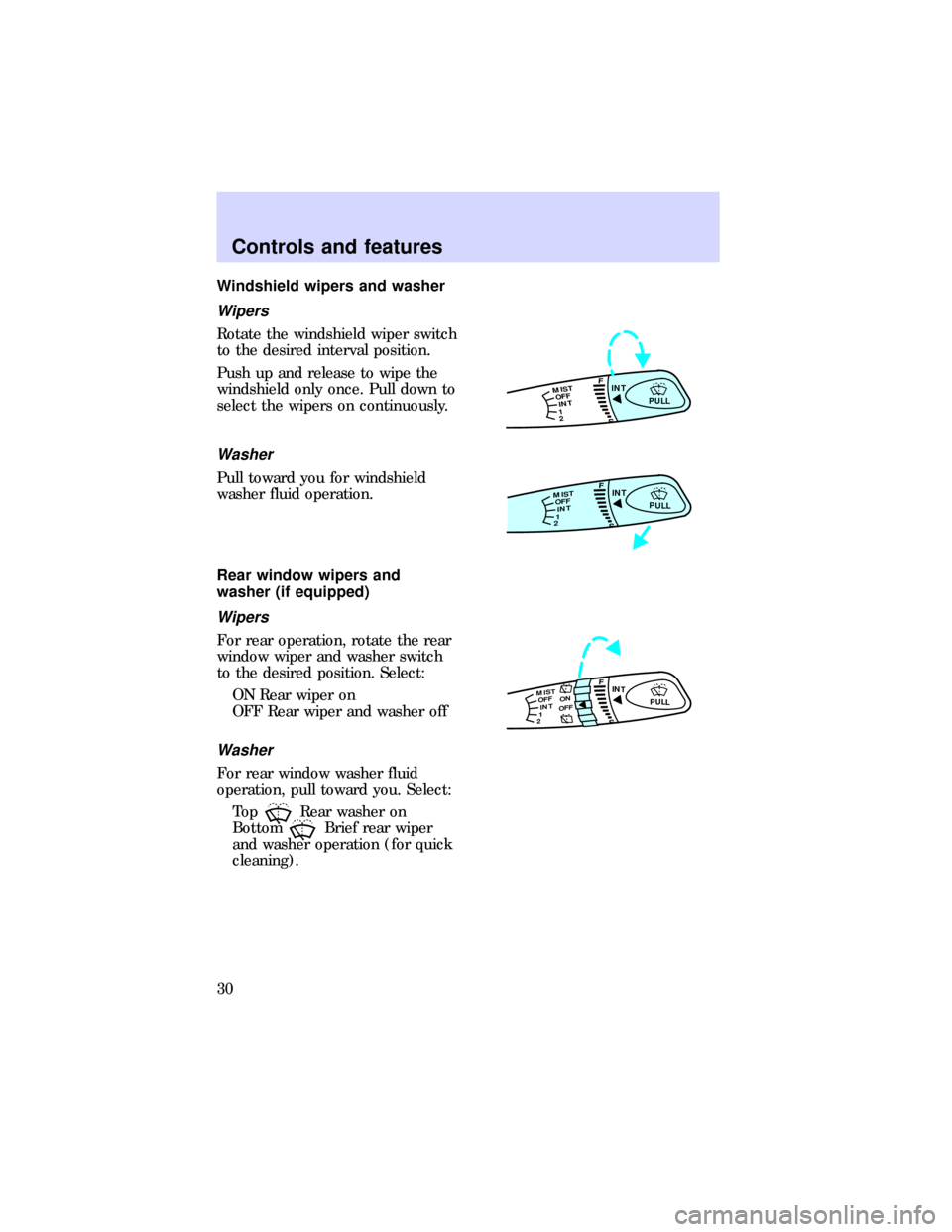
Windshield wipers and washer
Wipers
Rotate the windshield wiper switch
to the desired interval position.
Push up and release to wipe the
windshield only once. Pull down to
select the wipers on continuously.
Washer
Pull toward you for windshield
washer fluid operation.
Rear window wipers and
washer (if equipped)
Wipers
For rear operation, rotate the rear
window wiper and washer switch
to the desired position. Select:
ON Rear wiper on
OFF Rear wiper and washer off
Washer
For rear window washer fluid
operation, pull toward you. Select:
To p
Rear washer on
Bottom
Brief rear wiper
and washer operation (for quick
cleaning).
PULL INT
2INT
1 OFF MIST
PULL INT
2INT
1 OFF MIST
PULL INT
2INT
1 OFF MIST
ON
OFF
Controls and features
30
Page 129 of 191
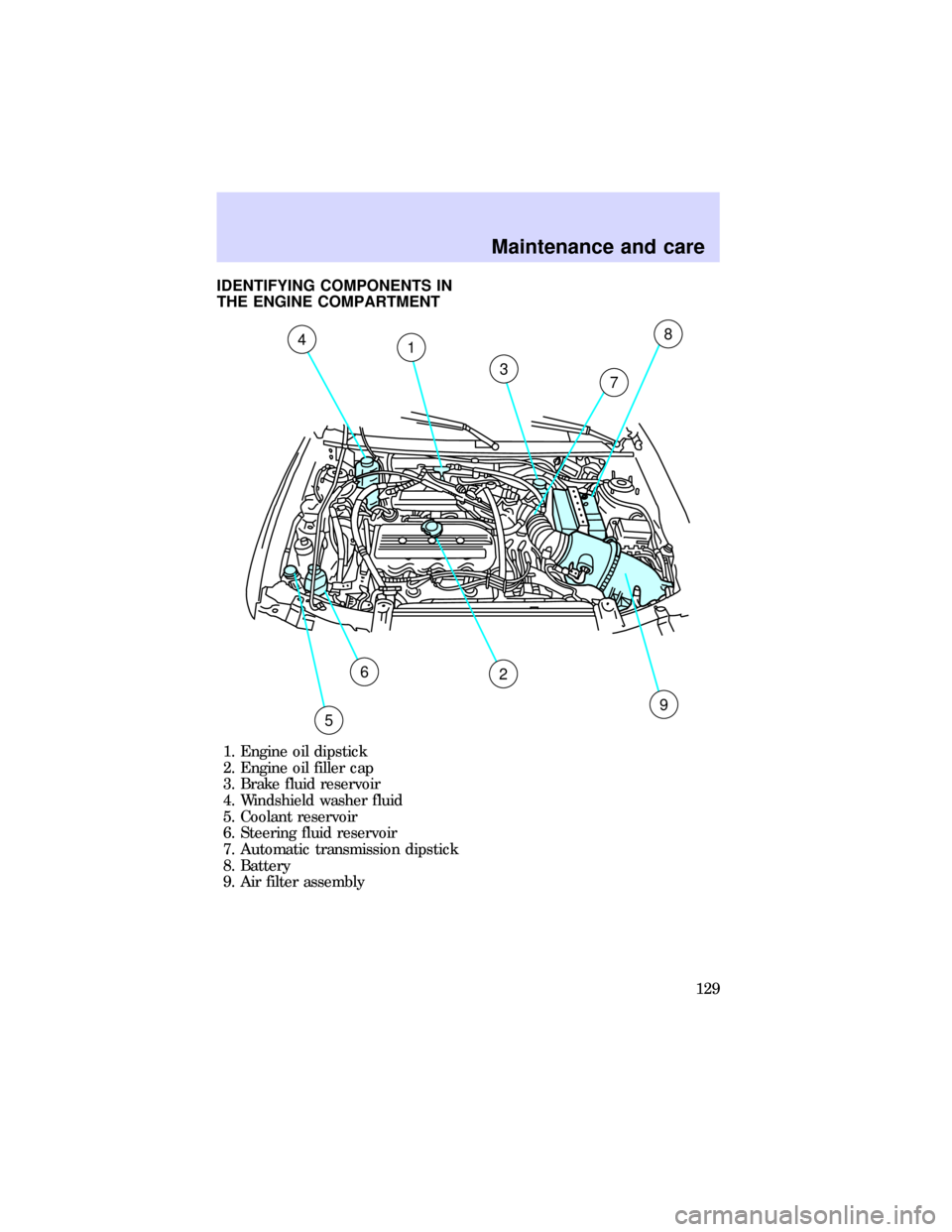
IDENTIFYING COMPONENTS IN
THE ENGINE COMPARTMENT
41
3
9
6
5
2
7
8
1. Engine oil dipstick
2. Engine oil filler cap
3. Brake fluid reservoir
4. Windshield washer fluid
5. Coolant reservoir
6. Steering fluid reservoir
7. Automatic transmission dipstick
8. Battery
9. Air filter assembly
Maintenance and care
129
Page 134 of 191
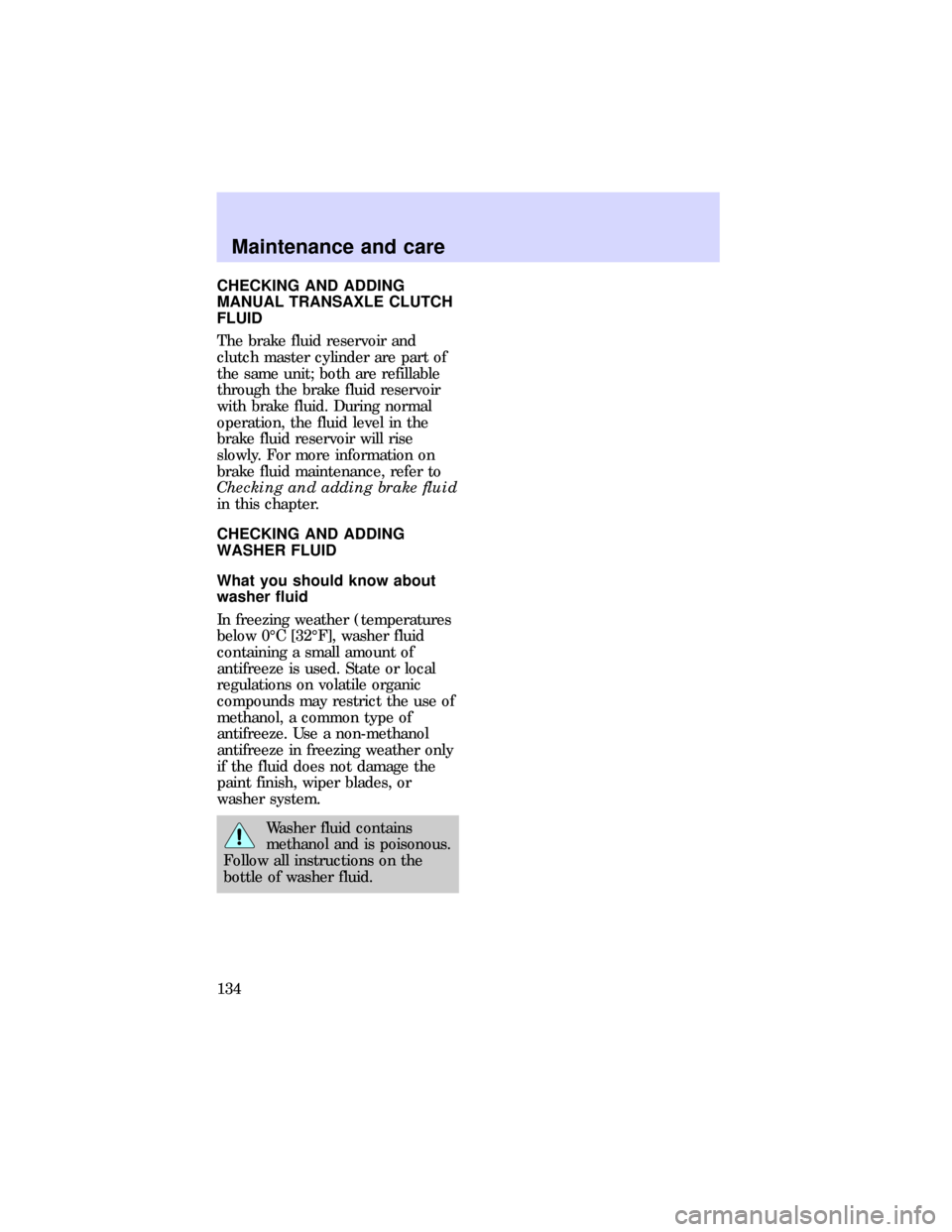
CHECKING AND ADDING
MANUAL TRANSAXLE CLUTCH
FLUID
The brake fluid reservoir and
clutch master cylinder are part of
the same unit; both are refillable
through the brake fluid reservoir
with brake fluid. During normal
operation, the fluid level in the
brake fluid reservoir will rise
slowly. For more information on
brake fluid maintenance, refer to
Checking and adding brake fluid
in this chapter.
CHECKING AND ADDING
WASHER FLUID
What you should know about
washer fluid
In freezing weather (temperatures
below 0ÉC [32ÉF], washer fluid
containing a small amount of
antifreeze is used. State or local
regulations on volatile organic
compounds may restrict the use of
methanol, a common type of
antifreeze. Use a non-methanol
antifreeze in freezing weather only
if the fluid does not damage the
paint finish, wiper blades, or
washer system.
Washer fluid contains
methanol and is poisonous.
Follow all instructions on the
bottle of washer fluid.
Maintenance and care
134
Page 135 of 191

Washer fluid for the windshield
reservoir
The vehicle's windshield washer
fluid reservoir is located on the
passenger side of the engine
compartment. If washer fluid needs
to be added to the reservoir:
²Lift the windshield reservoir
cover.
²Add enough washer fluid to fill
the reservoir.
Washer fluid for the liftgate (if
equipped)
The wagon's rear reservoir is
located on the passenger side of
the storage compartment. Remove
the access cover to locate the
washer reservoir cap. The reservoir
must be filled slowly to allow
trapped air to escape.
Maintenance and care
135
Page 136 of 191
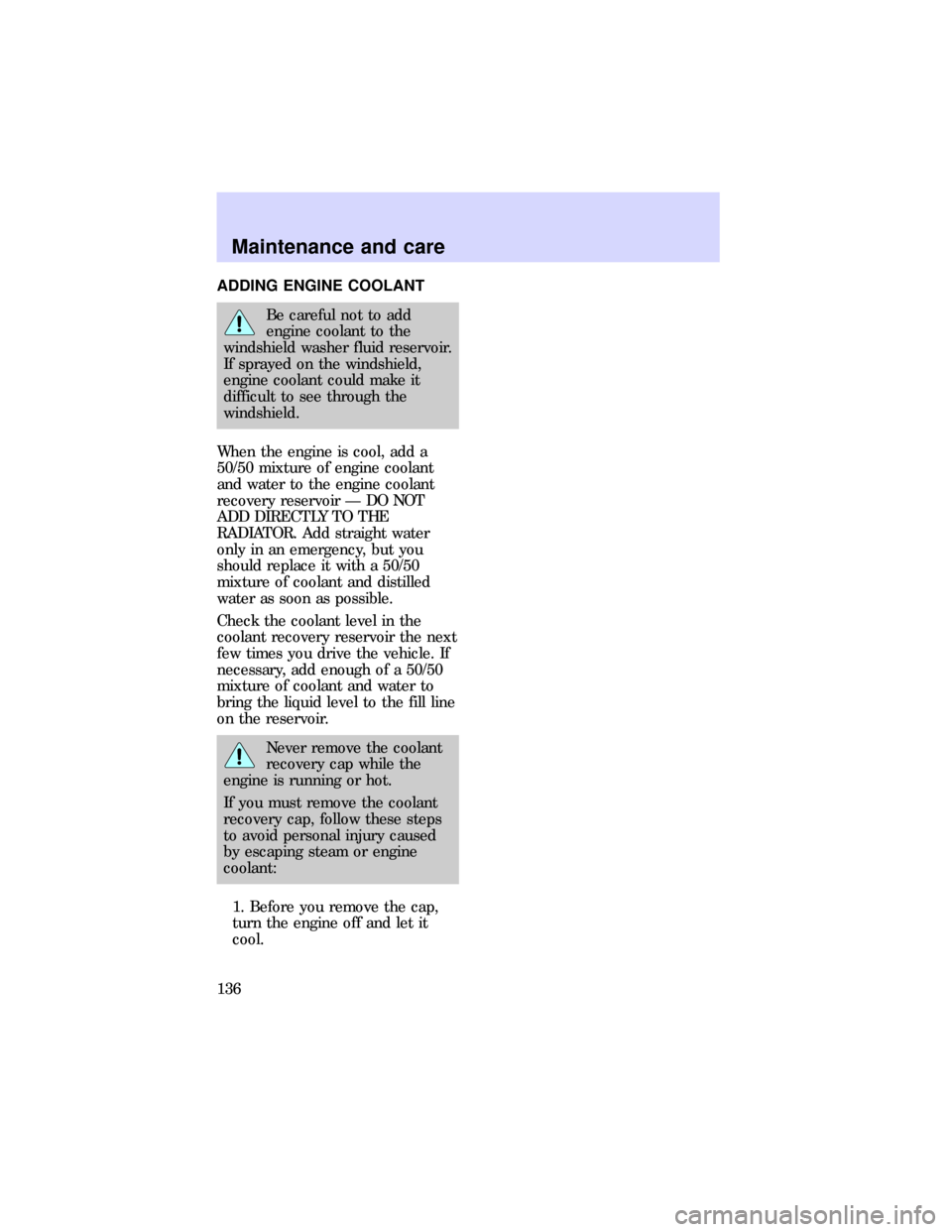
ADDING ENGINE COOLANT
Be careful not to add
engine coolant to the
windshield washer fluid reservoir.
If sprayed on the windshield,
engine coolant could make it
difficult to see through the
windshield.
When the engine is cool, add a
50/50 mixture of engine coolant
and water to the engine coolant
recovery reservoir Ð DO NOT
ADD DIRECTLY TO THE
RADIATOR. Add straight water
only in an emergency, but you
should replace it with a 50/50
mixture of coolant and distilled
water as soon as possible.
Check the coolant level in the
coolant recovery reservoir the next
few times you drive the vehicle. If
necessary, add enough of a 50/50
mixture of coolant and water to
bring the liquid level to the fill line
on the reservoir.
Never remove the coolant
recovery cap while the
engine is running or hot.
If you must remove the coolant
recovery cap, follow these steps
to avoid personal injury caused
by escaping steam or engine
coolant:
1. Before you remove the cap,
turn the engine off and let it
cool.
Maintenance and care
136
Page 169 of 191
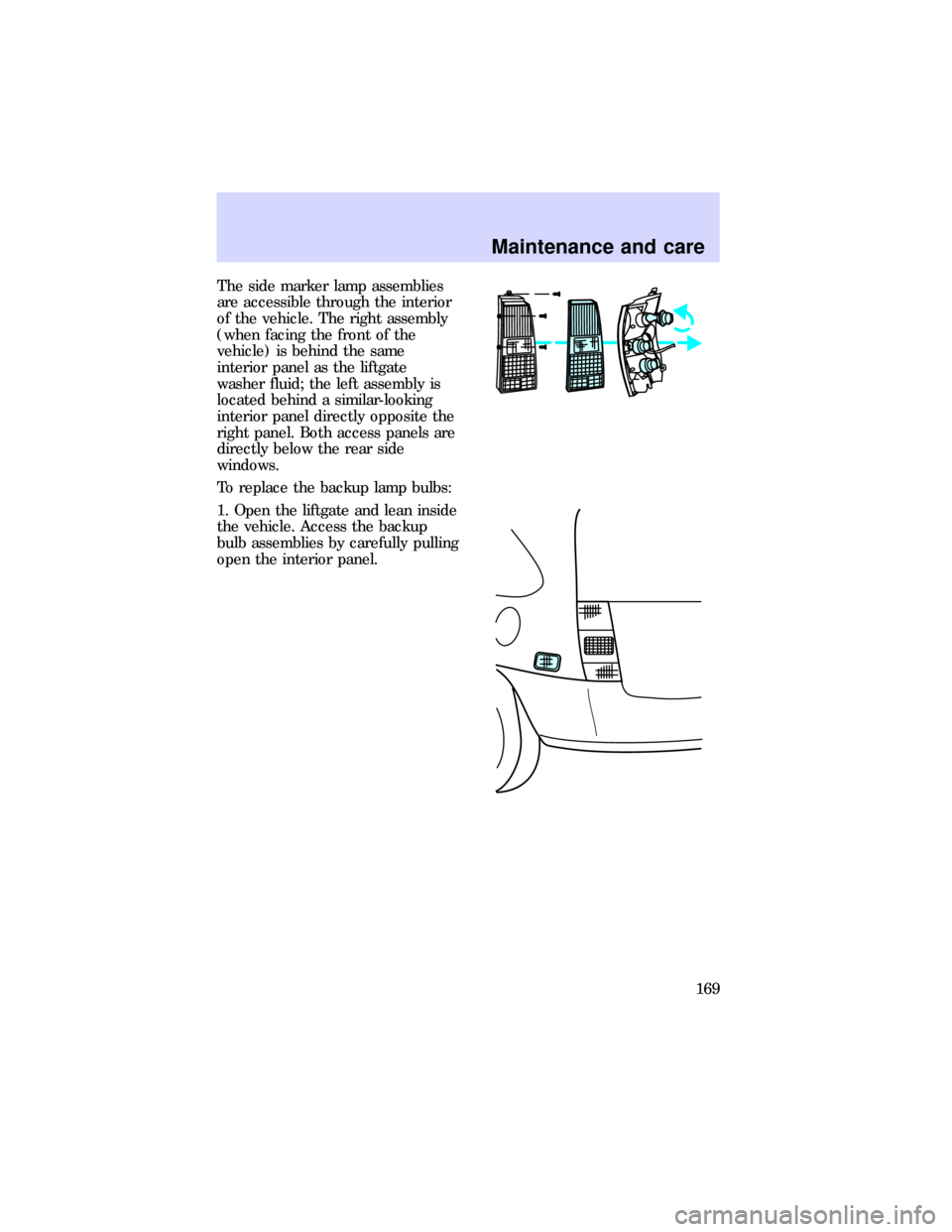
The side marker lamp assemblies
are accessible through the interior
of the vehicle. The right assembly
(when facing the front of the
vehicle) is behind the same
interior panel as the liftgate
washer fluid; the left assembly is
located behind a similar-looking
interior panel directly opposite the
right panel. Both access panels are
directly below the rear side
windows.
To replace the backup lamp bulbs:
1. Open the liftgate and lean inside
the vehicle. Access the backup
bulb assemblies by carefully pulling
open the interior panel.
Maintenance and care
169
Page 177 of 191
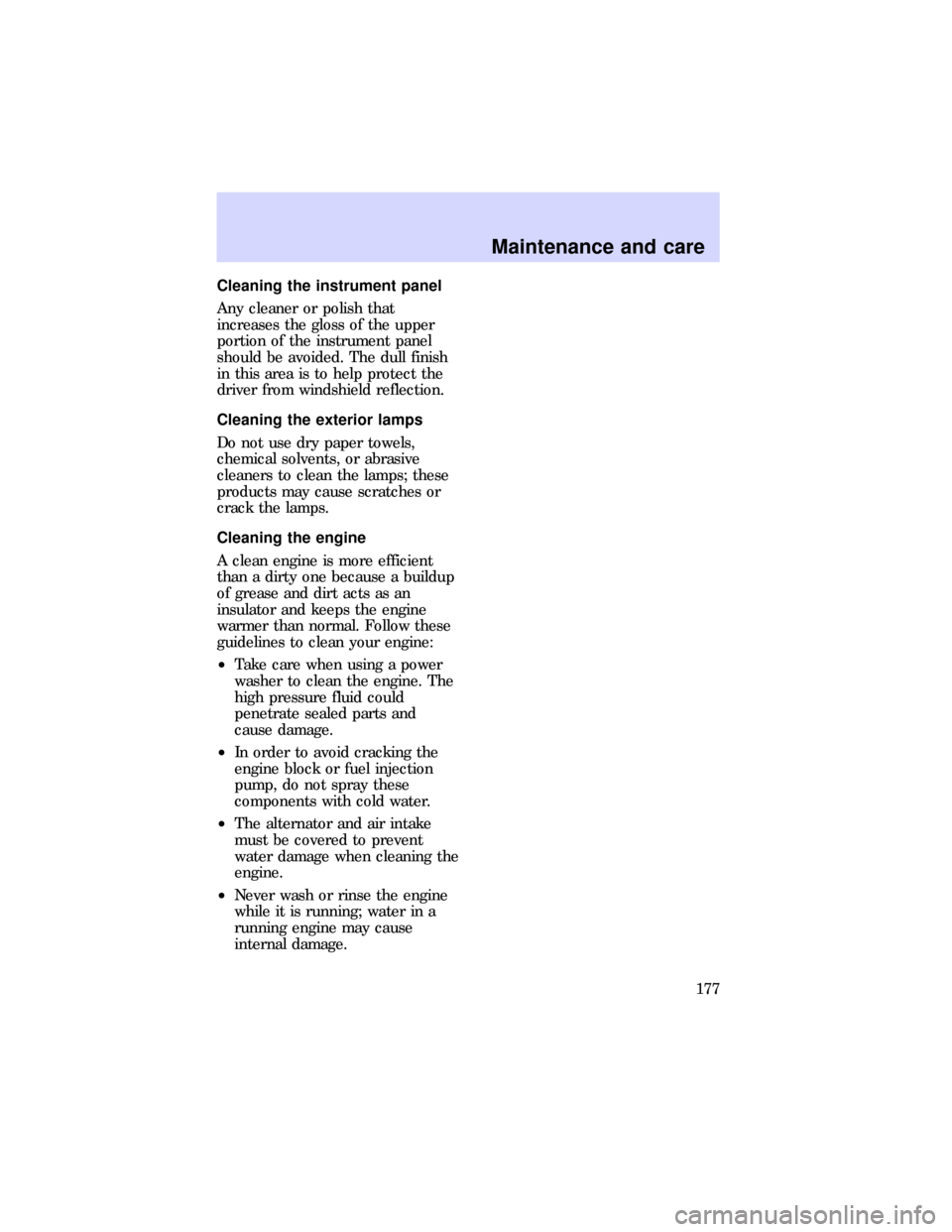
Cleaning the instrument panel
Any cleaner or polish that
increases the gloss of the upper
portion of the instrument panel
should be avoided. The dull finish
in this area is to help protect the
driver from windshield reflection.
Cleaning the exterior lamps
Do not use dry paper towels,
chemical solvents, or abrasive
cleaners to clean the lamps; these
products may cause scratches or
crack the lamps.
Cleaning the engine
A clean engine is more efficient
than a dirty one because a buildup
of grease and dirt acts as an
insulator and keeps the engine
warmer than normal. Follow these
guidelines to clean your engine:
²Take care when using a power
washer to clean the engine. The
high pressure fluid could
penetrate sealed parts and
cause damage.
²In order to avoid cracking the
engine block or fuel injection
pump, do not spray these
components with cold water.
²The alternator and air intake
must be covered to prevent
water damage when cleaning the
engine.
²Never wash or rinse the engine
while it is running; water in a
running engine may cause
internal damage.
Maintenance and care
177
Page 178 of 191
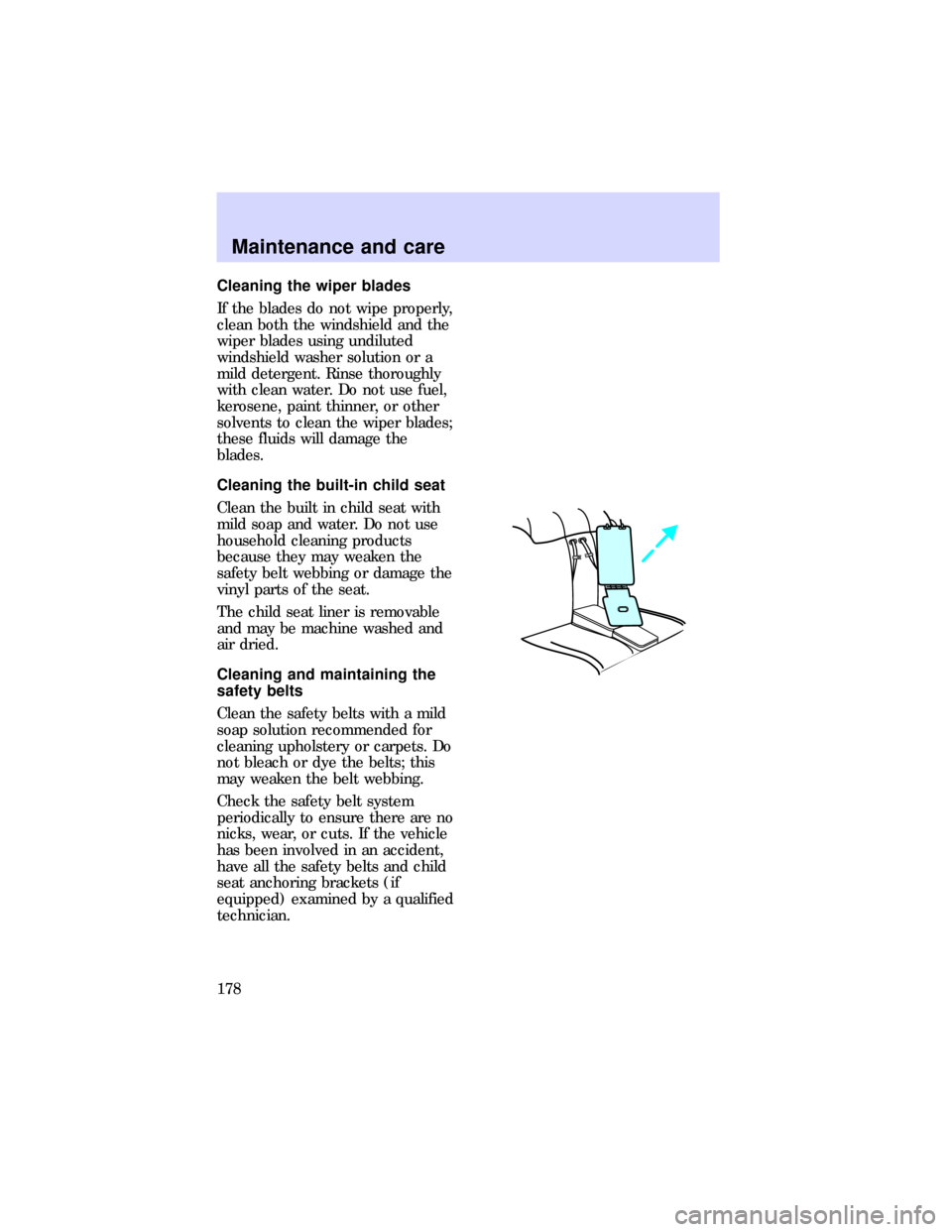
Cleaning the wiper blades
If the blades do not wipe properly,
clean both the windshield and the
wiper blades using undiluted
windshield washer solution or a
mild detergent. Rinse thoroughly
with clean water. Do not use fuel,
kerosene, paint thinner, or other
solvents to clean the wiper blades;
these fluids will damage the
blades.
Cleaning the built-in child seat
Clean the built in child seat with
mild soap and water. Do not use
household cleaning products
because they may weaken the
safety belt webbing or damage the
vinyl parts of the seat.
The child seat liner is removable
and may be machine washed and
air dried.
Cleaning and maintaining the
safety belts
Clean the safety belts with a mild
soap solution recommended for
cleaning upholstery or carpets. Do
not bleach or dye the belts; this
may weaken the belt webbing.
Check the safety belt system
periodically to ensure there are no
nicks, wear, or cuts. If the vehicle
has been involved in an accident,
have all the safety belts and child
seat anchoring brackets (if
equipped) examined by a qualified
technician.
Maintenance and care
178
Page 181 of 191

Item Ford part
nameFord part
numberFord
specification
Engine oil Motorcraft
5W-30 Super
Premium Motor
OilXO-5W-30 WSS-M2C153-F
Hinges and
latchesFord
Multi-Purpose
Grease Spray
(Aerosol)
F5AZ-19G209-AAESR-M1C159-A
and
ESB-M1C93A
Lock cylinders Penetrating
LubricantE8AZ-19A501-B N/A
Power steering
pumpPremium
Power Steering
FluidE6AZ-19582-AA ESW-M2C33-F
Automatic and
manual
transaxleMotorcraft
MERCONt
Multi-Purpose
(ATF)
Transmission
FluidXT-2-BDX,
-QDXMERCON
Wheel bearings,
rearMotorcraft
Premium
Long-Life
GreaseXG-1-C, -K ESA-M1C75-B
Windshield
washer fluid
reservoirUltra-Clear
Windshield
Washer
ConcentrateC9AZ-19550-AC
or
C9AZ-19550-BCESR-M17P5-A
Capacities and specifications
181
Page 189 of 191

Lights, warning and indicator ......6
air bag .....................................7,64
anti-lock brakes (ABS) ..............9
anti-theft .....................................9
brake ............................................8
charging system ..........................9
checkcoolant .............................10
high beam ...................................9
liftgate ajar ................................10
low fuel ........................................7
oil pressure .................................9
safety belt ...................................8
service engine soon ....................7
turn signal indicator ...................9
upshift indicator .........................8
Load limits .................................101
GVWR ......................................101
trailer towing ..........................102
Lubricant specifications ...........180
Luggage rack .............................106
Manual transaxle .........................99
driving .......................................99
fluid, checking and adding ....134
shifting gears ..........................100
Mirrors
side view mirrors (power) .......16
Motorcraft parts ........................179
National Highway Traffic
Safety Administration ...............186
Parking brake ..............................94
automatic release .....................38
operation ...................................94
warning light ...............................8
Parts (see Motorcraft Parts) ...179
Power door locks ........................31
Power features
door locks ..................................31
windows ....................................34
Power steering
fluid, checking and adding ....139
Rear window
defroster ....................................24washer .......................................30
wiper ..........................................30
Refill capacities for fluids ........179
Relays ........................................109
Remote control ...........................45
Remote entry system .................45
illuminated entry ......................49
locking/unlocking doors ......46,47
opening the trunk .....................47
panic alarm ...............................49
Repairing paint chips ...............176
Reporting safety defects ..........186
Restraints, safety(see Safety
restraints) ....................................55
head ...........................................54
infant .........................................67
Roadside emergencies ..............107
Safety chains, when towing a
trailer .........................................104
Safety defects, reporting ..........186
Safety restraints ..........................55
adjusting the safety belts .........59
automatic locking mode
(retractor) .................................57
for children ...............................65
lap and shoulder belts ........56,59
maintenance ..............................60
proper use ............................55,56
vehicle sensitive locking
mode ..........................................57
warning light and chime ..8,10,62
Safety seats for children ............67
automatic locking mode
(retractor) .................................81
built-in child seat .....................74
in front seat ..............................68
in rear seat ................................70
tether anchorage hardware .....71
Seats ............................................53
adjusting the seat, manual .......53
child safety seats ......................67
folding rear seats ......................54
Index
189